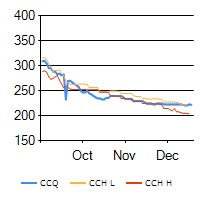
As gold again surged to record highs last night on dovish Bernanke comments and weak data, it’s time to revisit the rally.
I first began recommending gold to anyone that would listen in early 2001. I was laughed at.
Later that year, my friends laughed at me again. This time, it was a running joke that I had masterminded the September 11, 2001 terrorist attacks to boost the value of my very long gold holdings.
I sold some of my stake the following week and invested the profits into The Diplomat magazine.
So how did I draw my conclusion about gold?
First and foremost, it was the writing of Doug Noland at Prudent Bear. As the internet bubble burst spectacularly across the year 2000, Doug Noland wrote a weekly column that virtually never mentioned it. Rather, he focussed on the underlying dynamics of the US financial system, in particular the role of the Government Sponsored Enterprises (GSEs) Fannie Mare and Freddie Mac. And how the credit system itself was responsible for the bubble.
During the internet bust, Noland predicted with great precision the ultimate fate of the GSEs. He was proven extraordinarily correct seven years later during the GFC and still hasn’t received due credit.
By 2002, I had gotten in touch with Noland to write for The Diplomat. However, he was unable to do so at the time. Even so, through our conversation I discovered that he had completed his tertiary studies at the University of Western Sydney under a man he loudly sang the praises of, one Professor Steven Keen.
I got in touch with Steve and he wrote a piece for The Diplomat at the end of 2002 as America struggled to avoid the post-bust liquidity trap:
…there was indeed a new economy – it just wasn’t the one advertised. Rather than being built on high-tech manufacturing and labour productivity, the foundations of the new real economy were financial engineering, rampant speculation and debt.
Never before has the private sector risen so rapidly; never before has borrowed money been so freely squandered on frivolous and unprofitable investments; and never before has boomtime productive capacity been allowed to run so far ahead of demand. Individual and corporate debt in the US rose by more than US$5 trillion between 1995 and 2002, taking the ratio of private debt to GDP to its highest level in history; more than 160% and still rising. Manufacturing capacity utilisation never reached the level it attained during the preceding “jobless recovery”. It currently stands at 74%, far below the peak of 91 per cent attained regularly during the 1960s, but not far above the depth of 69% last plumbed during the 1982 recession.
Mr Greenspan’s past invincibility and current impotence are thus the same phenomenon displaced in time. America had salad days when the credit was being spent, but now that the capacity is installed and the fabled profits have failed to eventuate, the accumulated debt is crippling the economy.
The one thing that is keeping the economy going at this point is, predictably, yet more debt, which in an echo of post-1987 America (and Australia) is now financing housing construction rather than share purchases. It is only a matter of time before this zero-sum bubblegame also comes to an end. There is also the prospect of problems like Long Term Capital Management emanating from the enormous sums involved in derivatives (estimated at $US 110 trillion, or over 10 times the size of the US economy).
Mr Greenspan will doubtless wear the opprobium for these calamities as he once wore the garlands, but he is unworthy of either mantle. Central bankers have very little ability to constrain the financial system’s generation of credit, and what powers they once had were jettisoned over time with the fetish for financial deregulation. Their sole weapon today is the short end of the interest rate stick, and as Japan’s dismal performance during the 1990s has shown, low interest rates are as feeble palliative to debt-deflation as high rates were an impediment to irrational exuberance during the bubble.
And what does all of this have to do with today? My friends now curse when I mention gold. But they shouldn’t. The gold rally will be over only when stability returns to US monetary policy, the US (global) credit system and the $US.
For some clue about when that might be, here’s a chart of Japanese interest rates for the past thirty five years. Take note especially of the last sixteen:

The beauty of gold is that it’s a two way bet. Either overcapacity and demand shortage mean currency destroying stimulus is eternal. Or, it goes the other way, and inflation surges back globally via a debased $US and inflating commodities. My own view is we’ll see a dramatic lurching between the two as far as the eye can see.
Make no mistake, gold is very volatile. But in trend terms, the rally has just begun.

